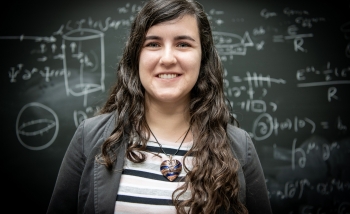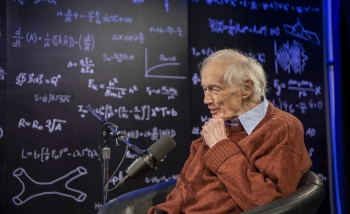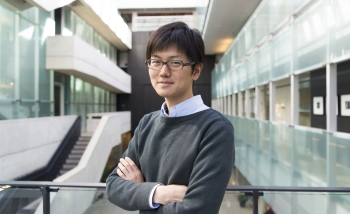Put a bunch of simple particles together, and radically new things can happen.
That’s the thrill – and the challenge – of the new science of quantum materials. Few people know it better than Dominic Else, one of Perimeter’s newest faculty members.
Else’s interest in the complex made simple, or the simple becoming complex, goes way back.
“I remember when I was in high school, they told us about Newton’s laws,” Else says. “If I put my hand on the table, I’m applying a force to the table, and the table is applying a force to my hand. They are equal and opposite.”
On the one hand, the system is very simple. Equal and opposite forces; action and reaction: Newton’s third law. Else fell in love with it. “The idea that we can understand how the world works in this basic, powerful way, through some very simple mathematical laws – to a particular kind of mind, that’s very appealing.”
On the other hand, if you zoom in, the point of contact between the hand and the table gets complicated. If we consider that the surface of the table is made of atoms – smaller-than-pinpoint concentrations of mass, with chemical bonds connecting them like knots in a net – then it takes a bit of work to understand what we mean by everyday words like surface or solid or touch.
Consider, for instance, metals. Conventionally, scientists think of metals as materials through which electrons can move freely. Physics gives us an exact description of those electrons and how they move – between electromagnetism and quantum field theory, physicists have developed a description of electron behaviour that’s full, correct, and exquisite in its precision.
“So then you would say, well, we understand electrons, and therefore we understand metals,” says Else. “But that’s not true. When you have a system of many, many electrons, all this incredibly rich behaviour can emerge from it. In practice, it’s impossible to explain one electron at a time.
“It’s kind of a contradiction to what I said before, about the appeal of simple laws. But it’s an exciting contradiction.”
Getting a handle on superconductors
Part of the reason we can’t say “We understand electrons, and therefore we understand metals” is simply scale. Even a pinprick of metal contains trillions upon trillions upon trillions of electrons. In these large systems, strange things can happen – things you might not have guessed at if you were thinking of the material one particle at a time.
A single drop of water, for instance, will have more than 1020 water molecules, each with the same well-defined properties. In different circumstances, that system of 1020 molecules might look like a raindrop or a snowflake or a puff of steam. The properties of the system as a whole that do not belong to its constituent parts – the surface tension of the raindrop or the symmetry of the snowflake, for example -- are said to be “emergent.”
Whole branches of physics have developed to handle the challenging mathematics and explain the emergent properties of systems.
The description of metals rests on seminal work done in the 1950s by Lev Landau, who described the free flow of charge in metals not in terms of electrons but in terms of emergent bundles of charge called “quasiparticles.” These quasiparticles obeyed Fermi statistics and flowed like liquids, and so Landau’s paradigm is also called Fermi liquid theory.
“It’s a confusing name – when you hear ‘liquid,’ you picture something you can pour out of a beaker,” says Else. “The actual materials are solid.”
Else’s attention has been caught by a handful of metals that can’t be described by the powerful and venerable Landau paradigm and its picture of quasiparticles flowing like liquids. Some of the emergent properties of these “non–Fermi liquid” metals are surprising – even revolutionary.
“In the 1980s,” Else recounts, “people discovered a class of materials, certain cuprates, that are superconductors at high temperatures. By ‘high temperature’ I mean about the temperature of liquid nitrogen – still cold, but much warmer than anything that had been discovered up until then.” The field exploded. “It was a revolution in physics,” says Else.
It turned out that, even above the superconducting temperature, these metals are unusual. They cannot be described as Fermi liquids or imagined using quasiparticles at all. The conventional mathematical tools and theoretical framework used to understand other metals simply don’t apply.
What to use instead? That’s one of the puzzles Else has his eye on.
Using quantum-informed mathematical tools – he’s interested in topological states of matter, for instance – he hopes to build a theoretical approach to metals that accounts for Fermi liquid and non–Fermi liquid metals alike. He works both backward and forward. That is, he both studies the known observables, looking for patterns and attempting to account for them theoretically, and feeds those patterns backward to make predictions about what experimentalists might observe.
For instance, Else is studying a technical feature of metals called the Fermi surface.
“So, in Fermi liquid theory, we understand Fermi surfaces well,” he says. “They are basically where the quasiparticles live. But it seems to be true from experiment that all metals, including non–Fermi liquid metals, have a Fermi surface. So, one thing I try to do is come up with general arguments. Is it true that any metal has a Fermi surface? What even is a Fermi surface in this more general setting, when it’s not related to quasiparticles?”
He adds, modestly: “We’re having some success.”
Exploring time crystals
This approach of stepping back and asking big questions has already led Else into interesting places: before joining Perimeter, he was one of the researchers who described a brand-new phase of matter that goes by the headline-catching name “time crystals.” If a crystal is a pattern that repeats in space, a time crystal is a pattern that repeats in time. This work won Else a prestigious New Horizons in Physics Prize.
“Time crystals somehow got a lot of attention – the name, you know – but they are simply an interesting quantum many-body system that has more than one phase of matter, with really sharp signatures when it moves from one phase to another. The major difference is that this occurs in the context of non-equilibrium systems.”
In other words, while we think of phases of matter as stable places where systems come to rest, the time crystal work shows that doesn’t have to be true. A stable phase can also be something that’s constantly shifting, something like the pendulum of a clock, if a clock pendulum could keep going without external power.
Again, this is a broadening of focus, a pushing-outward of definition, an expansion of tools. A generalization.
In physics, general is powerful.
Newton’s third law, the one that caught Else’s imagination in high school, is general: it explains how books rest on tables as tables push on books; how bird wings push down on air to get the air to push up on them; how the moon pulls the tides up on Earth even as the Earth’s pull keeps the moon in orbit. It’s a deep and simple statement: everywhere in the universe, forces come in pairs.
As systems get more and more complex, these deep laws can become more hidden, less useful. In the case of non–Fermi liquid metals, for instance, starting from electrons seems – remarkably – to be exactly the wrong approach. And yet by continuing to push paradigms outward, new generalisms can be uncovered.
It is, as Else says, an exciting contradiction.
About PI
Perimeter Institute is the world’s largest research hub devoted to theoretical physics. The independent Institute was founded in 1999 to foster breakthroughs in the fundamental understanding of our universe, from the smallest particles to the entire cosmos. Research at Perimeter is motivated by the understanding that fundamental science advances human knowledge and catalyzes innovation, and that today’s theoretical physics is tomorrow’s technology. Located in the Region of Waterloo, the not-for-profit Institute is a unique public-private endeavour, including the Governments of Ontario and Canada, that enables cutting-edge research, trains the next generation of scientific pioneers, and shares the power of physics through award-winning educational outreach and public engagement.
You might be interested in



